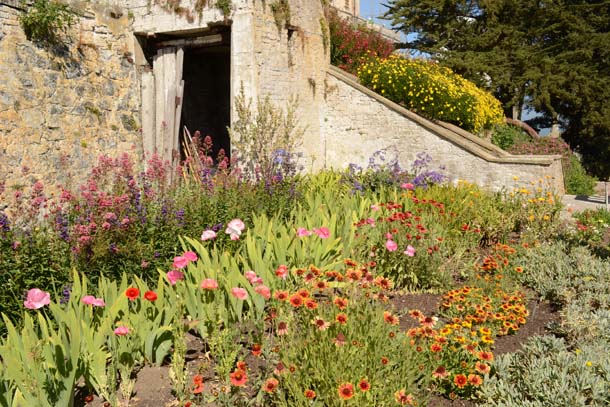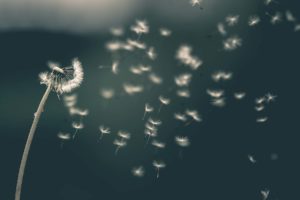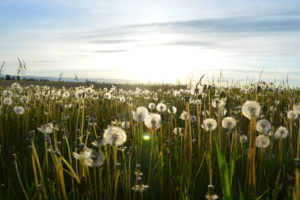From afar, this windswept island in the middle of the San Francisco Bay appears so rugged that you’d expect to find only century plants and eucalyptus. But Alcatraz is alive with color. Hidden amongst the leeward hillsides, flowers such as Mexican blanket, Shirley poppies and roses grow. Woody succulents and nasturtiums branch over the hillside on the windy western face, across from bright patches of sheltered bulbs and a patch of Matilda poppies.
Many of the plants are imported exotics, the result of decades of careful cultivation by staff and prisoners who created patches of beauty in the otherwise forlorn setting of concrete and steel. More than 200 species or varieties of plants have been introduced to the island since the late 1800s.
“Because Alcatraz is a cultural landscape, it is not as important to plant natives,” said Shelagh Fritz, the Garden Conservancy’s project manager for the Alcatraz Historic Gardens on a press tour of the gardens.
Historically, military officers, wardens and prisoners alike tended the well-manicured gardens on Alcatraz while living on the island. Although the once-barren island originally had a thin layer of topsoil and no source of freshwater, inhabitants of the island sought to make it more lively by planting exotic flowers, trees and shrubs.
The gardens were neglected for 40 years following the prison’s closure. By 2004, the Garden Conservancy, Golden Gate National Parks Conservancy, and the National Park Service partnered in an effort to revive the horticultural landscape of the island.
Every Wednesday and Friday mornings, the first boat to Alcatraz ferries volunteers wearing maroon shirts stating their mission: Alcatraz Garden Restoration. Cumulatively, they’ve put in 40,000 hours of work and revived 4.5 acres of gardens.
Apparently there was a lot to do; it took two years to clear out the overgrowth to reveal fuchsia, pelargonium, aeonium and rose bushes. The outline of garden paths and planting beds appeared and guided the volunteers. Old photographs brought by former Alcatraz residents and their families also provided visual references to restore the gardens.
Tucked into terraces
It’s easy miss the garden attractions if you head straight to the prison, as, no doubt, many tourists aim to do. Along the main pathway crisscrossing the island are the foundations of old homes, called Officer’s Row, where army officers lived during the military occupation of the island in the mid 19th Century before it was converted to a prison in 1861.
The army officers and their families established the Victorian-style gardens with topsoil that had been imported to the island to install cannons on the hillsides.

When management of Alcatraz switched the Bureau of Prisons in 1934, several of these homes were demolished, but the gardens survived. Staff families and inmates enlarged the terraced gardens around the homes to cultivate the land within the foundations. Only those prisoners who had rapport with the prison staff would be given the privilege of tending these gardens outside the prison walls.
Signs of their work remain. While clearing overgrowth from the Rose Terrace, Fritz found a handball, a small rubber ball inmates used during recreation.
“It felt pretty cool to hold something that was last touched by an inmate,” Fritz said.
Volunteers have intentionally left some of these gardens to nature, and nature is coming back. Where a burned down warden’s house once stood, black-crowned night herons now nest in the overgrown vegetation.
“It’s kind of interesting how plants just take over all the ruined buildings,” Fritz said.
The west side gardens withstand the harshest weather and are populated by climate-hardy, plants that grow in a Mediterranean climate like aloe and drosanthemums. Fig trees and snowy egret nests have taken over a former lawn used for inmate recreation.
One inmate, Eliot Michener, was considered a to be so non-threatening that he was allowed to care for gardens on the west side. He did so for nine years, 1941-1950, as if they were his own, creating a terraced design with ornamental plants.
A shining symbol of his work is the cottage-style garden near a small tool shed of his making. Annuals mixed with perrenials planted in a free-flowing, patchy landscaping design shout color and exuberate beauty. Fritz designed the restored garden, using flowers that closely represent what Michener had chosen more than 60 years prior. Stories such as this are important to Fritz and other volunteers. They create a connection across generations through the plants that survive in the severe conditions of the island.
“We want to restore the gardens, but we also want to tell those stories,” Fritz said.
Propagating plants
A reconstructed greenhouse stands not far from where Fritz picked up that handball. Fritz instructs volunteers how to propagate plants and set up experiments in hybridization.
“It’s fun to collect seeds and see what happens,” Fritz said.
The soil for the greenhouse plants is created less than 30 yards away through a composting system developed by Dick Miner, a Garden Conservancy volunteer. Miner spearheads the project in an effort to make the island more sustainable.
“We make our own dirt,” Miner said.
Miner uses ingredients from the island, including garden trimmings and waste; wood chips from ivy blackberries and roses; and coffee grounds from the gift shop. Horse manure from a farm down the road from Miner’s house adds extra nitrogen.

The result is a rich, compost soil that’s won awards in recent years in the Marin County Fair, most recently first place in 2012. What compost isn’t used to pot plants is applied back to the gardens.
Besides re-creating soil, Alcatraz’s new gardeners have found a way to solve another limitation of the island — the lack of freshwater. A barge brings water daily, but in 2009 volunteers saw potential in abandoned structures on the island, specifically large cisterns that used to recycle water from the prison showers to irrigate the recreation lawn on the west side.
With the help of landscape designers, the volunteers devised a catchment system to store rainwater and fog drip in the cisterns, which can hold up to 12,000 gallons. Water from the cisterns now feeds the western gardens.
“The best part is seeing the whole process take place, from clearing to planting and watching it all grow,” Fritz said.
She leads a guided tour through the gardens, some of which are normally closed to the public, twice a week Friday and Sunday mornings at 9:30 a.m., year-round. On Wednesdays from 11 a.m. to 2 p.m. one can listen in on garden talks in Officers’ Row.
Visit alcatrazgardens.org for more information.





